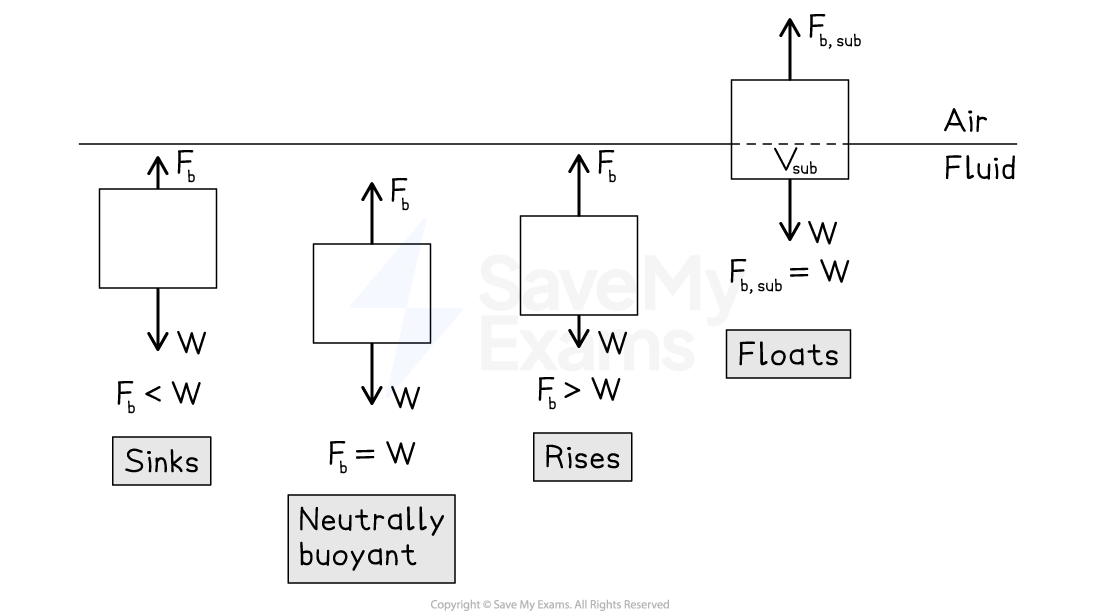Buoyant Force (College Board AP® Physics 1: Algebra-Based): Study Guide
Buoyant force
A buoyant force is a net upward force on an object in a fluid, arising from a pressure difference at its top and bottom
The pressure exerted on the surface of a submerged object is a result of the forces exerted on it by the particles making up the fluid
Recall that gauge pressure depends on depth only
Consider a submerged three-dimensional object, such as a cube:
It has multiple surfaces
Some surfaces are at different depths
These experience different pressures forces from the particles in the fluid
The cube's bottom surface experiences a greater pressure than the top surface and, therefore, a greater perpendicular force
There is a net upward force from the fluid, called the buoyant force
This buoyant force is a direct result of all the forces exerted on the object by the particles that make up the fluid
Pressure difference on a 3D object

Buoyant force equation
Archimedes' Principle
Archimedes' principle describes the size of this force:
The magnitude of buoyant force is equal to the weight of the fluid displaced by the object
One consequence of this is that buoyant force is independent of the object's mass
Two objects of identical shape but different masses will experience the same buoyancy
Buoyant force equation
In equation form, this buoyant force can be calculated as:
Where:
= buoyant force, measured in
= density of the fluid, measured in
= volume of fluid displaced, measured in
= acceleration due to gravity, measured in
Submerged volume
The volume in this equation refers to the volume of fluid displaced
This is equal to the volume of the object that is submerged in the fluid
In the above equation, the
term can cause confusion:
If the object is fully submerged,
is simply the object's volume
If the object is partially submerged,
is the volume of the object below the surface
Floating
An object experiences maximum buoyancy when it is fully submerged
Here, it displaces the greatest amount of fluid
If the object's weight is greater than this buoyant force, the object will sink
There is a net force downwards
If the object's weight matches this buoyant force, the object will remain submerged but not sink
This is sometimes called neutral buoyancy
If the object's weight is less than the maximum buoyant force, the object will float
The amount of the object which is submerged is such that the buoyant force is equal to the object's weight
Conditions for floating and sinking

Worked Example
A wooden cube hangs from a Newton meter, which reads a force of 16.0 N. When the wooden cube is submerged in oil to exactly half its height, the reading on the Newton meter is 12.0 N. When the reading is taken, the wooden cube is at rest and does not touch the sides of the container.
The density of the oil is 700 kg/m3.
What is the width of the wooden cube?
A 0.6 cm
B 8.4 cm
C 11.0 cm
D 15.0 cm
The correct answer is C
Answer:
Step 1: Analyze the scenario
When the cube is not submerged, the Newton meter reading is 16.0 N - this is the cube's weight
When the cube is submerged halfway, the measured weight is reduced
The buoyant force from the oil causes this perceived reduction in weight
Only half of the cube's volume is displacing fluid
Step 2: Determine the size of the buoyant force
When submerged, the Newton meter measures a net force of 12.0 N
The net force is equal to the difference between the weight (where
= 16.0N) and the buoyant force
The buoyant force on the cube is 4.0 N
Step 3: Determine the volume of fluid displaced
The magnitude of the buoyant force is:
Where
is the volume of fluid displaced and
is the density of the fluid, which is 700 kg/m3 for oil
Rearrange for the volume of fluid displaced:
Option A can be discounted, as this is the volume of fluid displaced, not the width of the cube
Step 4: Determine the width of the cube
The volume of fluid displaced is equal to half the volume of the cube
The volume of a cube is given by the equation
Where
is the length of all sides of the cube, including width
Substituting this and rearranging for
gives the width of the cube
This most closely matches option C

You've read 0 of your 5 free study guides this week
Unlock more, it's free!
Did this page help you?